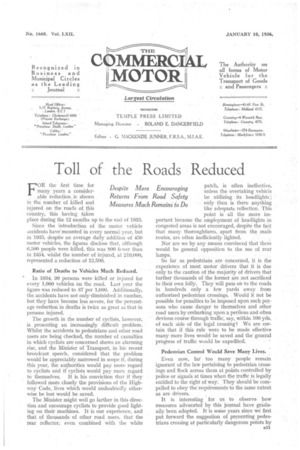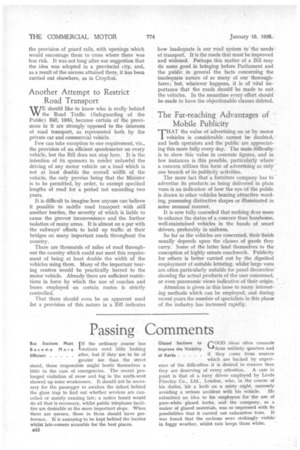Toll of the Roads Reduced
Page 29

Page 30

If you've noticed an error in this article please click here to report it so we can fix it.
FOR the first time for many years a considerable reduction, is shown in the number of killed and injured on the roads of this country, this having taken place during the 12 months up to the end of 1935.
Since the introduction of the motor vehicle accidents have' mounted in every normal year, but in 1935, despite an average daily addition of 450 motor vehicles, the figures disclose that, although 6,500 people were killed, this was 800 fewer than in 1934, whilst the number of injured, at 219,000, represented a reduction of 12,500.
Ratio of Deaths to Vehicles Much Reduced.
In 1934, 99 persons were killed or injured for every 1,000 vehicles on the road. Last year the figure was reduced to 87 per 1,000. Additionally, the accidents have not only diminished in number, but they have become less severe, for the percentage reduction in deaths is twice as great as that in persons injured.
The growth in the number of cyclists, however, is presenting an increasingly difficult problem. Whilst the accidents to pedestrians and other road users are being checked, the number of casualties in which 'cyclists are concerned shows an alarming rise, and the Minister of Transport, in his recent broadcast speech, considered that the problem would be appreciably narrowed in scope if, during this year, the authorities would pay more regard to cyclists and if cyclists would pay more regard to themselves. It is his conviction that if they followed more closely the provisions of the Highway Code, lives which would undoubtedly otherwise be lost would be saved.
The Minister might well go farther in this direction and encourage cyclists to provide good lighting on their machines. It is our experience, and that of thousands of other road users, that the rear reflector; even combined with the white patch, is often ineffective, unless the overtaking vehicle be utilizing its headlights"; only then is there anything like adequate reflection. This point is all the more important because the employment of headlights in congested areas is not encouraged, despite the fact that many thoroughfares, apart from the main routes, are often inefficiently lighted.
Nor are we by any means convinced that there would be general opposition to the use of rear lamps.
So far as pedestrians are concerned, it is the experience of most motor drivers that it is due only to the caution of the majority of drivers that further thousands of the former are not sacrificed to their on folly. They will pass on to the roads in hundreds only a few yards away from authorized pedestrian crossings. Would it not be possible for penalties to be imposed upon such persons who cause danger to themselves and other road users by embarking upon a perilous and often devious course through traffic, say, within 100 yds. of each side of the legal crossing? We are certain that if this rule were to be made effective many more lives would be saved and the general progress of traffic would be expedited.
Pedestrian Control Would Save Many Lives.
Even now, far too many people remain ignorant of the law pertaining to pedestrian crossings and flock across them at points controlled by police or signals at times when the traffic is legally entitled to the right of way. They should be cornpelled to obey the requirements to the same extent as are drivers.
It is interesting for us to observe how measures advocated by this journal have gradually been adopted. It is some years since we first put forward the suggestion of proventing pedestrians crossing at particularly dangerous points by the provision of guard rails, with openings which would encourage them to cross where there was less risk. It was not long after our suggestion that the idea was adopted in a provincial city, and, as a result of the success attained there, it has been carried out elsewhere, as in Croydon..
Another Attempt to Restrict Road Transport
WE should like to know who is really behind the Road Traffic (Safeguarding of the Public) Bill, 1935, because certain of the provisions in it are strongly 'opposed to the interests of road transport, as represented both by the private car and commercial vehicle.
Few can take exception to one requirement, viz., the provision of an efficient speedometer on every vehicle, but the Bill does not stop here. It is the intention of its sponsors to render. unlawful the driving of any motor vehicle on a road which is not at least double the overall width of the vehicle, the only proviso being that the Minister is to be permitted, by order, to exempt specified lengths of road for a period not exceeding two years.
It is difficult to imagine how anyone can believe it possible to saddle road transport with still another burden, the severity of which is liable to cause the gravest inconvenience and the further isolation of many areas. It is almost on a par with the railways' efforts to hold up traffic at their bridges on many important roads throughout the country.
There are thousands of miles of road throughout the country which could not meet this requirement of being at least double the width of the vehicles using them. Many of the important touring centres would be practically barred to the motor vehicle. Already there are sufficient restrictions in force by which the size of coaches and buses employed on certain routes is strictly controlled.
That there should even be an apparent need for a provision of this nature in a Bill indicates how inadequate is our road system to the needs of transport. It is the roads that must be improved and widened. Perhaps this matter of a Bill may do some good in bringing before Parliament and the public in general the facts concerning the inadequate nature of so many of our thoroughfares ; but, whatever happens, it is of vital importance that the roads should be made to suit the vehicles. In the meantime every effort should be made to have the objectionable clauses deleted.
The Far-reaching Advantages of • Mobile Publicity
THAT the value of advertising on or by motor 1 vehicles is considerable cannot be doubted,and both operators and the public are appreciating this more fully every day. The main difficulty is to show this value in concrete figures, and in few instances is this possible, particularly where a concern utilizes this forth of advertising as only one branch of its publicity activities.
The mere fact that a furniture company has to advertise its products as being delivered in plain vans is an indication of how the eye of the public is drawn to other vehicles bearing attractive wording. possessing distinctive shapes or illuminated in some unusual manner.
It is now fully conceded that nothing dies more to enhance the status of a concern than handsome, well-maintained vehicles in the hands of smart drivers, preferably in uniform.
So far as the vehicles are concerned, their finish usually depends upon the classes of goods they carry. Some of the latter lend themselves to the conception of highly ornate coachwork. Publicity for others is better carried out by the dignified employment of suitable lettering, whilst large vans are often particularly suitable for panel decoration ' showing the actual products of the user concerned, or even panoramic views indicative of their origin.
Attention is given in this issue to many interesting methods which can be employed, and during recent years the number of specialists in this phase of the industry has increased rapidly.




































































































